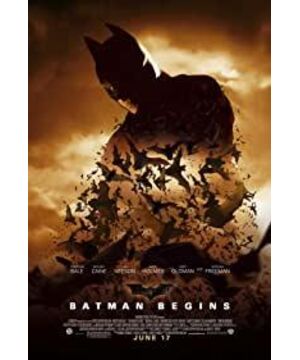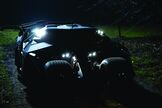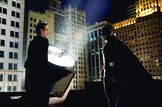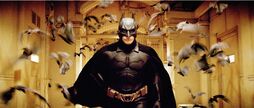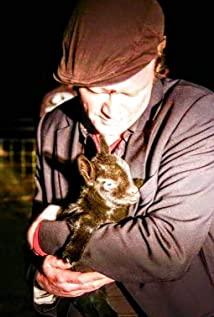The first segment: a large number of bats are flying all over the screen, and the image of a big bat appears faintly.
Analysis: Simply put, of course this is a symbol of Batman. Going deeper, most viewers should be frightened when they first see this situation without prompting. This is also the "fear" that the movie wants to express. The reason for the formation of a large bat image is to express a kind of "available fear", which actually laid the groundwork for the explanation after the film.
The second clip: Bruce and Rachel are playing hide-and-seek, Bruce falls into the well with a spear, the bat swarms in the well, and Bruce wakes up.
Analysis: This was Bruce's first contact with bats, and from this moment on, bats began to become his inner fear.
The third segment: Bruce is confined for fighting, and the ninja master appears and talks with him.
Analysis: This is an important segment of the film. It is the first confrontation between the pros and cons of the film. The ninja master said that the Kagemusha alliance is to fight crime. Bruce pointed out that they are lynchers. The ninja master explained that only those who lose in the competition are lynchers. They are often imprisoned. Only by surpassing their limits and devoting themselves to their ideals can they become legends. This should explain the earliest origin of Batman's birth. Afterwards, Bruce and Ah Fu mentioned that the use of bats as a symbol should refer to this one. Although the ninja master said this, it is not the case in the Kagemusha League. Isn't the justice they advertised based on their own standards? In other words, it is the driving force that drives them. The specific reason why the League of Shadow Warriors cannot cultivate Batman will be elaborated in the summary article. But one thing is certain: both the League of Shadow Warriors and Batman act for the same goal-to exceed the limit and become a legend.
The fourth segment: Bruce went up the mountain to find the Kagemusha League, and fell into a coma after fighting with the ninja master.
Analysis: Here is a conversation saying that Bruce wants to fight criminals and needs to "transform fear into fear that can deal with them." At this time, the ninja master pointed out that he still failed to overcome his own fear, and he could not apply fear to others. It is pointed out here that Bruce is still full of fear of the childhood bat colony, which he has not been able to overcome.
The fifth segment: Father rescues Bruce, Bruce returns the spear to Rachel.
Analysis: I won’t talk about “falling and climbing” here. The key is that spears and bats are both primitive symbols, the latter symbolizes fear, and the former symbolizes strength and attack. It should be said that these two items paved the way for the birth of Batman.
The sixth segment: Father talking with Bruce, on the bed, on the train.
Analysis: Here, father mentioned that "you will be aggressive only if you have fear", which may imply a sequence. As for the conversation on the train, it was pointed out that my father relied on public welfare to help the poor.
The seventh segment: Going to see the opera, Bruce thinks of the situation in the Bat Cave and urges his parents to leave early together. As a result, he is shot and killed by a robber in a back alley, and Bruce loses his parents.
Analysis: Here is the birth point of the first conflict: Bruce and the robber. Bruce therefore shifted the responsibility of the death of his parents to his fears and the robbers. Since then, the plot mainly focuses on how Bruce solves these two problems.
The eighth segment: A series of training
analysis of Bruce by Master Ninja: Master Master Ninja here mainly teaches Bruce how to accept the angry reality. Another point is that when it comes to a murderous farmer, the Kagemusha Alliance’s approach is to put to death and not tolerate rape. This is also their consistent principle.
The ninth segment: the conversation between the ninja master and Bruce and the memories of the robbers and how Bruce came to the Shadow Warrior Alliance step by step.
Analysis: The same is the loss of a loved one, because you can't just rely on anger to suppress pain and ruin your life one day, but Bruce and Master Ninja have chosen different approaches. The ninja master chose revenge, thereby suppressing anger and pain; and because the robber would confess the secret of the underworld boss-he was killed, so Bruce had no way to revenge himself. Rachel accused him of ignoring the situation of the people who lived as hard as the robber Qi Li for his own personal enmity. He pointed out that it was the existence of the underworld boss that caused the poverty of the citizens. The real justice is to fight against the underworld boss. And the triad boss also "educates" that you care too much, you don't know what civil suffering is, just confined to your own private hatred. Of course, from this moment on, Bruce understood that the justice he needs to be done should be a kind of transcendence (that is, unknown) and broader (that is, not limited to private enmity, but from the standpoint of the entire society. ) Justice. Knowing this truth, Bruce solved the problem of the robber's private vengeance, and he began to penetrate the criminal's psychology to solve his fear problem. The ninja master pointed out that he was actually a fear of himself rather than a fear of criminals. Bruce himself has no worries about food and clothing, and he does not have the fear of the underprivileged when he commits a crime. What he has to overcome is his own fear, the fear of the powerful destruction that his own anger can cause. Finally, Master Ninja pointed out the two most important reasons that contributed to Bruce Wayne becoming Batman: becoming a fear itself and becoming an invisible fear.
The tenth clip: Bruce passed the training, but because he had a disagreement with the Kagemusha League on the issue of killing farmers, and learned that they were going to destroy Gotham City’s plan, he destroyed the Kagemusha League and went out of Duka (Ninja). Grandmaster).
Analysis: This should be the first climax of the entire movie. The second conflict of the film broke out: the conflict between Bruce and the Kagemusha League. As for how to become fear itself, I also said in the summary. Here, killing the farmer became the fuse of the conflict between Bruce and the Kagemusha Alliance. The Kagemusha Alliance killed farmers and destroyed Gotham City in order to eliminate crime and rebuild justice, and Bruce believed that Gotham City was still saved and could not be destroyed. This also directly led to the future conflict between Batman and the Shadow Warrior Alliance: the principle of the former is not to kill people, but to submit the criminals to the court for trial; the latter believes that all crimes should be destroyed. Here, Bruce's sentence is very intriguing: "This is the difference between me and them." The difference is to deal with evil through trial or lynching.
The eleventh segment: the dialogue between Bruce and Ah Fu on the plane.
Analysis: Here is the third contradiction of the film: the contradiction between Bruce and his father. His father believed that as long as the rich and poor in Gotham City were encouraged to help the poor through charity, social stability could be maintained, but his death proved that such a gentle approach was not feasible. Bruce chose to use a symbol (please pay attention to the wording here, in fact, the definition of Batman has been clarified very early here, Batman is a symbol, and the personal flesh is only the carrier)-it is both primitive and Going beyond the personal, broad and fearful characteristics, and fighting crime with strong force to maintain social stability, this is exactly what makes Bruce different from his father.
The twelfth segment: Bruce's conversation with Ah Fu early in the morning after catching the gang boss as Batman.
Analysis: There is nothing to say here, but Ah Fu has a saying "If you pretend to have fun, maybe you can really find happiness." Actually, Ah Fu started to persuade Bruce to live an ordinary life very early.
The thirteenth segment: After Bruce takes two hot girls to play in the hotel, the conversation with Rachel at the door.
Analysis: Here is the fourth contradiction of the film: the contradiction between Bruce and Rachel. Bruce said he "I'm not just that superficial, I actually have more", but Rachel replied "It doesn't matter who you are, what you do is important". As a DA, Rachel believes that reliance on the law can convict bad people, and that only through legal and formal means can we combat crime; and Bruce believes that because there are too few people with integrity, we can only rely on means beyond the law to assist the law against criminals. Trial.
The fourteenth segment: The dialogue between Master Ninja and Bruce before the final battle, before Bruce’s house is burned.
Analysis: This is the foreplay of the climax part of the film, and the main contradictions of the film are concentrated here. The Kagemusha League has played the role of destruction and reconstruction for hundreds of years. There is one point here. Ninja masters said that they had tried to destroy Gotham City before, but they were stopped by Bruce's father and other kind people. The working people they helped killed in turn killed the people who helped them. This time the Kagemusha Alliance returned once again to destroy Gotham City. From this point, it can be seen that the Kagemusha Alliance does not regard whether a city has reached a point where it is hopeless, but based on their own standards. In other words, the Kagemusha Alliance considers itself a god and has the highest power to decide the life and death of a city, and the standards of the ruling are all set by themselves! Here, it can be seen that Bruce's rescue of Gotham City through Batman is actually the greatest excavation of social value. The League of Shadow Warriors ignores the objective existence of society for its own existence, and Batman in turn is its biggest defender.
Fifteenth segment: The conversation between Bruce and Rachel on the ruins of Wayne's mansion.
Analysis: Here is the first time Rachel reveals his thoughts to Brustein: "The person I love deeply, he left a few years ago, and is still in a corner of the world. He has not returned. One day Gotham will no longer need it. Batman, maybe I will see him again.” It can be seen from here that Rachel wants Bruce, who is beloved, not Batman. She cannot accept a man wearing a mask to protect Gotham City—a Think of ordinary people as a symbol of a skin bag. The specific analysis will be explained in the summary. However, it needs to be pointed out that this also laid the groundwork for the fate of Rachel, Bruce and Harvey Dent in the second "Dark Knight".
Probably for the entire "Batman Prequel 1: Hour of War", after all, because it is Nolan's first Batman movie, the commerciality is still greater than the content. However, the opposition between the League of Shadows and Batman has been established, and this It is also a beginning under the framework of the big background constructed by the trilogy. It is worth noting that a large number of dialogues in the film have actually paved the way for the next two parts. In general, this is a story about how Batman was born. The birth of Batman is greater than the discussion of the entire city society. This is a story of overcoming and becoming fear, and using it to fight crime.
View more about Batman Begins reviews


